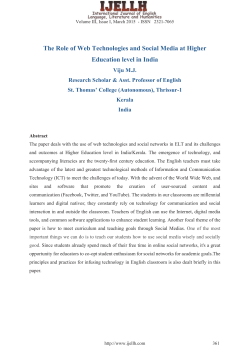
Hullabaloo in the Guava Orchard: An Existential Reading Dr
9ROXPH,,,,VVXH,0DUFK,661 +XOODEDORRLQWKH*XDYD2UFKDUG$Q([LVWHQWLDO5HDGLQJ 'U6KUHHMD6KDUPD ,QGHSHQGHQWUHVHDUFKHU %KRSDO Hullabaloo in the Guava Orchard is the debut novel of, the Man Booker Prize winning writer Kiran Desai. Desai launched herself on the literary landscape with her excerpt Strange Happenings in the Guava Orchard published in the New Yorker and in Mirrorwork, an anthology of 50 years of Indian writing edited by Salman Rushdie. In 1998, she extended her work into the comic fable Hullabaloo in the Guava Orchard. It won instant admiration and went on to win the Betty Trask Award, a prize given by the Society of Authors for the best new novels from citizens of the Commonwealth Nations under the age of thirty-five. The novel, well appreciated as an enchanting comic fable, carries a message much deeper. This paper explores the nuances of existentialism buried at the core, of the light and humorous Hullabaloo in the Guava Orchard with reference to interpretation of the protagonist Sampath. The character Sampath progresses on a psychological plane in existential terms when he moves out of the town of Shahkot, which is a microcosm for the materialistic world into the open space of freedom and spirituality when he finds abode in a guava orchard. Existentialism is particularly a post–World War II phenomenon, rising considerably in the 1940s. Jean-Paul Sartre and his associates are recognized for establishing the philosophy in France, and later introducing it to America. Existentialism is popularly understood as a, “sense of disorientation and confusion in the face of an apparently meaningless or absurd world.” The themes such as despair, death, hopelessness, alienation, meaninglessness, freedom and free will, absurdity and a quest for spiritual meaning in an incoherent, unkind meaningless universe are typified in existential works of prominent writers such as Albert Camus’s The Myth of Sisyphus, and The Stranger, Franz Kafka’s The Trial, Fyodor Dostoyevsky’s Notes from Underground, J. D. Salinger’s The Catcher in the Rye and J.M Coetzee’s Life and Times of Mr. K. Desai’s work is popularly understood and cherished as a delightful comic fable with an enchanting tinge of magic realism. However, her work at its heart, hints at a message much deeper. Through her character Sampath, Desai offers a glimpse of the contemporary society which is KWWSZZZLMHOOKFRP 9ROXPH,,,,VVXH,0DUFK,661 materialistic, opportunistic, pretentious and superficial. The finer qualities of innocence, naivety and creativity are throttled by the oppressive crudities, rigidities and customs of the society. It is ironic that Sampath who is an embodiment of the finer side of human existence is regarded and purposefully presented as eccentric. His climbing the guava tree symbolically reflects his moving away from the worldly existence and coming close to nature and following the path to enlightenment. While Sampath lives in Shahkot, his existence seems to be meaningless, trivial and absurd. However, as he leaves the worldly life, to live on a tree, he is exalted to the status of a saint. Desai’s character perhaps shows us that in the meaningless, despondent, existential world there is somewhere a ray of hope, which can bring happiness with the full realization of the inner self. The novel humorously laughs on the follies of the contemporary society and social constructs, emphasizing the meaningless nature of the world where absurd events take place. The surreal atmosphere of the novel is set for us to imagine what happens to Sampath when he leads a life after renouncing the society. The spiritual undercurrent of self – realization as the key to bringing meaningfulness cannot be missed. The town of Shahkot is a microcosm of the Indian society, cultural practices, religious beliefs, superstitions and corrupt bureaucracy. It is also a symbol of oppression and the encroachment of individual freedom, in general. The ambience of Shahkot paints the picture of a world busy in mundane affairs of a materialistic, worldly existence. Places like the bazaar at the center of the town, provide insight on the divisions of class, customs and manners. Also, the government post office, where Sampath worked is a symbol for corrupt practices and of ordinary routine activities undertaken diligently for the sake of human existence. The central theme of the novel is the destruction of the free will of man and nature by common enemies, society and culture. Desai describes the annihilation of the natural order of things by activities of humans. In the beginning of the novel, Sampath’s father, Mr. Chawala reads aloud, reports from newspapers explaining the causes for the drought in Shahkot, apparently “created” by activities of man. Similarly, when Sampath runs away to the guava orchard, he comes in close communion with nature and breaks free from the impositions of society and culture. His ruffled being is calm at last and he feels at peace after have moved away from his home, from the post office and from Shahkot. Sitting perched on the tree among monkeys and being mistakenly worshipped as a Baba, he experiences eternal happiness. However, his blissful unity with nature cannot continue uninterrupted for long. As soon he is acclaimed as a hermit and the mob of devotees, flies and KWWSZZZLMHOOKFRP 9ROXPH,,,,VVXH,0DUFK,661 hovers around him in bees. The orchard thus, begins to resemble a city; the transition is symbolized by the monkeys gulping alcohol left as offering and terrorizing the pilgrims and even Sampath. It is as though the monkeys represent the rage of nature due to the destruction of it at the hands of man. Thus, the inevitable outcome of battle between man and nature is clear and Desai forewarns the same through her characters and developments. In the course of the novel, Sampath begins to feel alienated from the material as apparent by his oblivion to the surroundings and those around him:“. . . the neighbourhood houses seemed to rise like a trap, a maze of staircases and walls with windows that opened only to look into one another” (HGO, 43). To him, the sky looks like "a series of squares and rectangles, the pieces of a jigsaw puzzle which is cut off by clothes lines and aerials...a world of dark gaps cut from an empty skin of light” (HGO 17). He begins to dreams of 'open spaces', not being 'interrupted by the material world' and heads towards the guava orchard, his natural abode, to fill these gaps. After moving to the orchard Sampath, overcomes the pressures put on him by the mechanical motion of his Shahkot life and enters into a realm of spiritual tranquility and observes:“I am not going to live anywhere but in this tree” (HGO 127). He realizes that, “he had seen the world in absolute clarity for the first time . . .The sunlight coming in through the leaves at daybreak, shifting and flickering, breathing its fire-breath upon the bark, falling now and then upon Sampath, whom it treated as if he were not the solid being that he was, scattering him like water." (HGO 142-43) Sampath is confronted with the pressing existential question, "What does it mean to be existing as a human being?” His decisions and choices help him transcend the worldly materialistic society towards an isolated, alienated realm of the guava orchard. His spiritual quest in the guise of Monkey Baba highlights the dubious credentials of religious gurus and is a comic expose of the meaninglessness in the universe. It is notable that Desai mixes absurdity and existentialism with comedy much like Samuel Beckett and his likes; her style however is characteristically her own. While Sampath moves away from the worldly town of Shahkot into the spiritual realm of the guava orchard in search of meaning in existential terms; Desai’s narrative remains light, comic and entertaining. Her humor is gentle, never bitter or sarcastic. And behind the veil of humor, lies the façade of existentialism waiting to be lifted and discovered. KWWSZZZLMHOOKFRP 9ROXPH,,,,VVXH,0DUFK,661 5HIHUHQFHV Camus, Albert. The Myth of Sisyphus, New York: Vintage Books, a Division of Random House.1983. Print. -------The Stranger. New York: Vintage Books, a Division of Random House, 1942. Print. Coetzee, J.M. Life and Times of Mr. K. UK: Penguin Publishing Group, 1983. Print. Desai, Kiran. Hullabaloo in the Guava Orchard. U.K: Faber, 1998.Print. Dostoyevsky, Fyodor. Notes from Underground, Nw York: Classic House Books, 2008.Print. Flynn, Thomas R. Existentialism: A Very Short Introduction. U.K: OUP. 2006. Print Kafka, Franz. The Trial, UK: Penguin Books, 2001.Print. Nityanandam, Indira. The Fictional World Of: Kiran Desai. New Delhi: Creative, 2010.Print. Salinger, J. D. The Catcher in the Rye. UK: Penguin Books, 2010. Print. KWWSZZZLMHOOKFRP
© Copyright 2025









